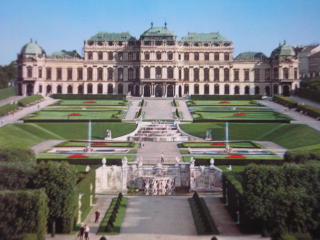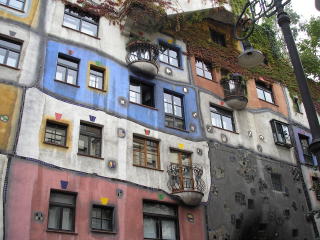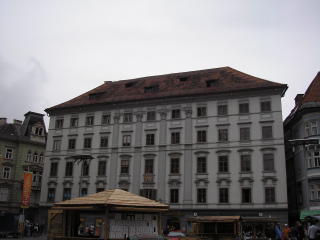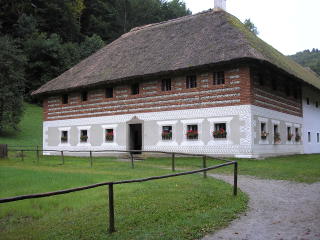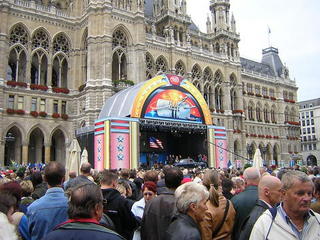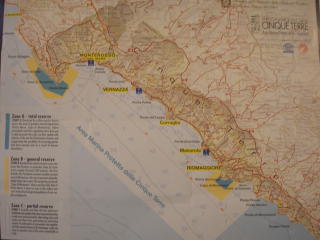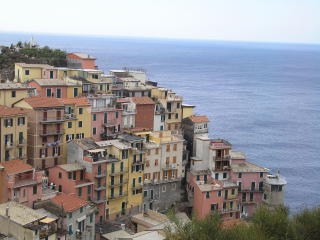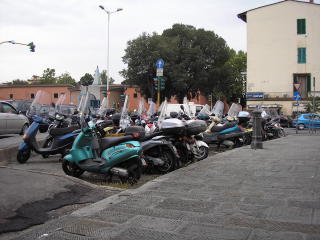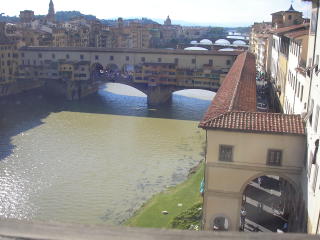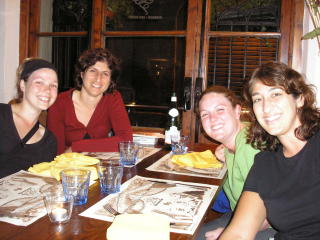Orientation – Part Two (19.09.2005 – 24.09.2005)
On Monday (19.09.2005), we toured Schloss Schonbrunn, which was the summer home of the Habsburgs. It is an enormous place, and very overwhelming because there is so much to see. Schonbrunn was originally a hunting lodge until it was given to Empress Maria Theresia by her father. Maria Theresia remodeled the entire palace and the grounds extensively, and the palace and grounds still look the same as they did during her time. We took a two-hour tour of the house, and I was amazed by how ornate all of the furnishings are. As a side note, the palace has an interesting heating system. Each room has an elaborate porcelain furnace in one corner. These furnaces are lit from passages that are built inside the walls of the rooms, so that the smoke and dust from the furnaces does not go into the living spaces of the palace. Another interesting fact that I learned was that Empress Maria Theresia had sixteen children (and 11 of them survived to adulthood), which is an amazing accomplishment considering that she was alive during the 1700s.
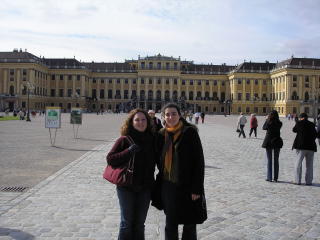
Ottakringer Brewery
On Tuesday (20.09.2005), we went to the Ottakringer Brewery in Vienna. Ottakringer is a very popular beer in Vienna, probably because it is brewed right here in town and it is cheap. Now, most of you know that I don’t like to drink beer. And after visiting the brewery, I can still say that I don’t like to drink beer. However, I did enjoy the tour of the brewery. Our tour guide had never given a tour of the brewery in English (he normally gives the tours in German), but he did very well. The picture below shows the bottling room at the brewery. If you look to the right of the Inspektions-maschine, you can see a blurry green line of beer bottles as they whiz by on the bottling line.

United Nations Office
On Thursday (22.09.2005), we visited the United Nations Office at the Vienna International Center. The UNO in Vienna is the third headquarters for the UN (behind the NYC office and the Geneva office). It was established on 01.01.1980 (the day before I was born!) and is the headquarters for the UN Office on Drugs and Crime and the UN Office for Outer Space Affairs. During our visit, we watched a video on the UN as a whole, and had a lecture on the United Nations Industrial Development Organization, which is an organization devoted to helping to bring economic development to third world countries. The picture below shows Lara and I with some of our friends (from left to right: me, Stefan, Lara, Alberto, Eugeno, Roser) in front of the United Nations Office.
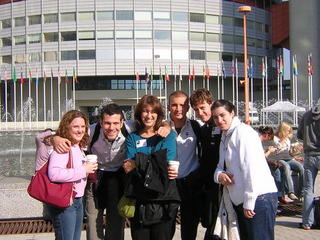
Stift Melk and the Nastl Wiengut, Keller, und Heuriger
Saturday (24.09.2005) was a busy day! First, we went to the town of Melk and visited the Stift Melk (Melk Abbey). Before we toured the abbey, we were able to go into the gardens for about 45 minutes. The gardens were gorgeous, and the weather was perfect as well! We wandered about, and followed a little map that we picked up from the entrance to the gardens. Two of my favorite places were the Pavilion and the historical water basin. The pavilion was built in the 1700s for the monks’ recreation and it is filled with amazing frescoes. (By the way, I didn’t know the difference between a fresco and a mural, so I found a great website that explained it. Go to Fresco Techniques and Materials and you can find out the difference too!)

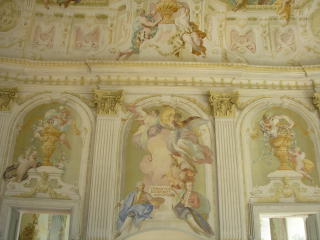 The historical water basin is an interesting place because of the sculpture in the center of it. The sculpture tells the story of Jesus walking on the water towards his disciples, and Peter getting out of the boat to meet him. As Peter begins to walk on the water, his fear overcomes him, and he starts to sink, and Jesus reaches out and saves him, saying “Have faith, be not afraid!”
The historical water basin is an interesting place because of the sculpture in the center of it. The sculpture tells the story of Jesus walking on the water towards his disciples, and Peter getting out of the boat to meet him. As Peter begins to walk on the water, his fear overcomes him, and he starts to sink, and Jesus reaches out and saves him, saying “Have faith, be not afraid!”
 After we finished walking through the gardens, we took a guided tour of the abbey museum. It was beautiful! The museum is set up in the Imperial Wing of the abbey, where Maria Theresia and her entourage stayed when they were traveling to the western part of Austria. The Imperial Wing has several hundred rooms, and it always had to be prepared for Maria Theresia, in case she needed to stay there. And with all of this preparation, she only stayed at the abbey three times during her lifetime. One other interesting fact is that the Austrian people used ‘reusable’ coffins in the 18th century in order to save money. Instead of burying a person in a normal coffin, they would put them in a coffin with a trap door on the bottom for the funeral. After the coffin was lowered into the grave, the gravedigger would pull on a latch, and the bottom of the coffin would open, allowing the body to fall into the grave. The coffin would then be pulled back out of the grave to be used again for someone else.
After we finished walking through the gardens, we took a guided tour of the abbey museum. It was beautiful! The museum is set up in the Imperial Wing of the abbey, where Maria Theresia and her entourage stayed when they were traveling to the western part of Austria. The Imperial Wing has several hundred rooms, and it always had to be prepared for Maria Theresia, in case she needed to stay there. And with all of this preparation, she only stayed at the abbey three times during her lifetime. One other interesting fact is that the Austrian people used ‘reusable’ coffins in the 18th century in order to save money. Instead of burying a person in a normal coffin, they would put them in a coffin with a trap door on the bottom for the funeral. After the coffin was lowered into the grave, the gravedigger would pull on a latch, and the bottom of the coffin would open, allowing the body to fall into the grave. The coffin would then be pulled back out of the grave to be used again for someone else.

In the afternoon, we visited the Nastl Weingut, Keller, und Heuriger (Nastl Vineyard, Cellar, and New Wine Tavern). A Heuriger is a wine tavern that sells ‘new wine’, that is, wine that is from the current year’s vintage. These places are common in Austria, and the wine is very good and relatively cheap. Gunter and Renate Nastl own the winery, and Renate took us on a tour of the vineyards. She also showed us the wine cellar, which is very modern. The Nastls produce about 40,000 bottles of wine a year, and their family has been operating the winery since 1659. The picture below is of Lara and me with Renate Nastl. If you would like to know more about their winery, you can go to www.nastl.at.
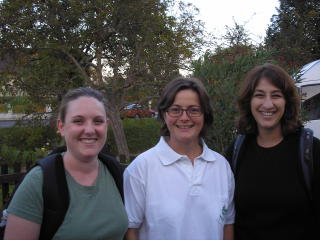 Renate told us an interesting story as we were touring the wine cellar. We walked past some wooden barrels, and she told us that this is where they ferment the red wine. The first three barrels in the foreground of the picture are for each of her three children. Red wine was put in a barrel for each child in the year that they were born, and they will get it when they are grown. That’s a pretty nice inheritance!
Renate told us an interesting story as we were touring the wine cellar. We walked past some wooden barrels, and she told us that this is where they ferment the red wine. The first three barrels in the foreground of the picture are for each of her three children. Red wine was put in a barrel for each child in the year that they were born, and they will get it when they are grown. That’s a pretty nice inheritance!

After the tour of the vineyards and the wine cellar, we had a wine-tasting in the Heuriger. The Nastls make some very nice wine, and I bought two bottles of their Sauvignon Blanc 2004 before we left.
The Park at Schloss Schonbrunn
On Sunday (25.09.2005), we went back to Schonbrunn to visit the gardens. It was well worth the visit! It is difficult for me to find the words to describe how massive the gardens are. Just to give you an idea, my guidebook said that 20 hectares of grass have to be mowed 21 times a year. Since one hectare is about 2.5 acres, that’s equivalent to almost 50 acres of grass. And that doesn’t include all of the trees, bushes, and flowers in the park that need to be cared for. Needless to say, it is a massive undertaking for the gardening staff at Schonbrunn, and there is always something that needs to be done in the gardens. The picture below shows a rolling scaffolding that is used to trim the trees in the park.
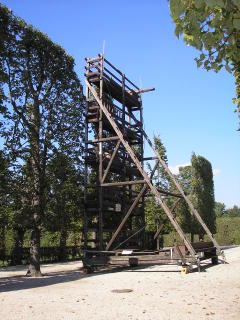 Lara and I climbed to the Gloriette, which is on a hill overlooking the back side of Schloss Schonbrunn. We could see the entire city of Vienna from there, and it was amazing. Even though we have been to Schonbrunn twice, we have only seen about half of the exhibits on the estate. I know that I will have to go back at least one more time to see the Palm House and Sundial House, the oldest zoo in Europe, the Roman Ruins, the Court Bakery (where I can get a recipe for apple strudel – yum!), the Carriage Museum, the Small Gloriette, the Maze, the Schone Brunnen, the Obelisk Fountain, and the Japanese Garden. Look for more info on these places in an upcoming post!
Lara and I climbed to the Gloriette, which is on a hill overlooking the back side of Schloss Schonbrunn. We could see the entire city of Vienna from there, and it was amazing. Even though we have been to Schonbrunn twice, we have only seen about half of the exhibits on the estate. I know that I will have to go back at least one more time to see the Palm House and Sundial House, the oldest zoo in Europe, the Roman Ruins, the Court Bakery (where I can get a recipe for apple strudel – yum!), the Carriage Museum, the Small Gloriette, the Maze, the Schone Brunnen, the Obelisk Fountain, and the Japanese Garden. Look for more info on these places in an upcoming post!
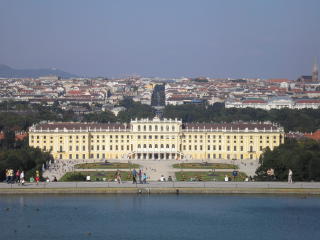
Well, that concludes my travels during orientation. Tomorrow, I leave for a two day trip to a mountain hut in the Alps, and then it’s on to Budapest for two days! Look for updates to my photo album in the next few days here.
~Andria
